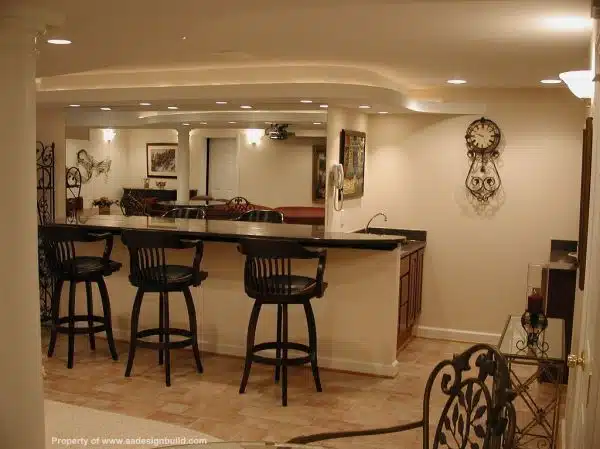In today’s world, home theaters are becoming increasingly popular as people seek to create the ultimate entertainment experience in the comfort of their own homes. However, building a DIY home theater room can be a daunting task, especially for those who lack knowledge about acoustics and audiovisual technology. As a home theater design consultant with years of experience in this field, I am here to guide you through the process of building your dream home theater room.
A DIY home theater room is not just about putting up a big-screen TV or projector and some speakers. It involves careful planning and execution to ensure that every aspect of the room is designed to provide an immersive audiovisual experience. From selecting the right equipment to optimizing the layout and acoustics of the room, there are several factors that must be considered to create a space that delivers cinematic quality entertainment at home. In this article, I will share my expertise on how to build a DIY home theater room that meets your needs and budget while providing an unforgettable movie-watching experience for you and your loved ones.
Determining Your Budget And Goals
To successfully build a DIY home theater room, it is crucial to start by determining your budget and goals. Setting realistic expectations is key in ensuring that your project stays within your financial means while also meeting your desired outcome. It is essential to consider all the elements you would like to include in your home theater room before deciding on a budget.
Researching equipment options is another vital step in determining your budget and goals for your DIY home theater project. This step involves looking into various types of audio and visual equipment, such as speakers, receivers, projectors, and screens, among others. You should aim to purchase high-quality equipment that meets both your technical requirements and budget.
Once you have set a realistic budget and researched suitable equipment options for your DIY home theater room, the next step is choosing the right room. The location of the room can significantly impact the overall quality of sound and picture in your theater room. Consider factors such as noise levels from adjacent rooms or outside noise sources when selecting the perfect space for building your DIY home theater room.
Choosing The Right Room
When designing a home theater room, the size of the room is an important factor to consider since it will determine the capacity of the theater, as well as the locations of the audio and video equipment.
Room acoustics should also be taken into consideration, as soundproofing and acoustic treatments can minimize echoes and reverberations, enhancing the sound quality of the theater.
The lighting design of the room can also have an impact on the viewing experience, by adjusting the light levels to create the desired atmosphere.
When considering the size of the room, it is important to remember that larger rooms can often provide greater flexibility in terms of seating arrangement and equipment placement.
Acoustic treatments such as soundproofing and acoustic panels can help to reduce sound reflections, resulting in a more enjoyable audio experience.
A variety of lighting fixtures and color temperatures can be used to create the desired ambiance in the home theater room, from bright and vivid to more subdued and intimate.
Room Size
Maximizing space is one of the key considerations when choosing the right room for your home theater. A larger room may seem like a better option, but it can actually lead to problems with acoustics and seating arrangements. A smaller room can provide a more intimate viewing experience and allow for easier placement of speakers and seating.
Acoustics are also an important factor to consider when choosing the right room for your home theater. The shape of the room, along with any hard surfaces or furnishings, can greatly impact sound quality. For example, a square or rectangular room can create standing waves that distort sound, while curtains or acoustic panels can help absorb sound reflections and improve overall acoustics.
When it comes to seating arrangements, consider how many people will be using the home theater at once. This will determine the number of seats needed as well as their placement. Keep in mind that each seat should have a clear view of the screen and adequate space for movement. It’s also important to consider whether you want traditional theater-style seating or something more casual like sofas or recliners. By taking these factors into account, you can choose a room that maximizes space while providing optimal acoustics and seating arrangements for your home theater.
Room Acoustics
As a home theater design consultant, choosing the right room for your home theater is crucial to achieving optimal audio and visual experience. In addition to maximizing space and seating arrangements, one should also consider the importance of room acoustics. The shape of the room, furnishings, and hard surfaces can greatly impact sound quality.
Acoustic treatments are essential in improving the overall sound quality in your home theater. Curtains or acoustic panels can help absorb sound reflections and minimize any unwanted echoes in the room. Proper speaker placement is also necessary to achieve optimal acoustics. The distance between speakers and walls should be taken into account to prevent any sound distortions or reflections.
When designing a home theater, it’s important to consider various factors that can affect its performance. Room acoustics play a significant role in delivering an immersive audio experience. By incorporating proper acoustic treatments and speaker placement, you can create a perfect environment where sound travels evenly throughout the room, giving you an exceptional audio experience that will rival even commercial cinemas.
Room Lighting
When it comes to designing the perfect home theater, choosing the right room is just one aspect of the process. While acoustics play a significant role in delivering an immersive audio experience, lighting is also an important factor to consider. Proper room lighting can enhance your viewing experience and even set the mood for a more enjoyable movie night.
One way to achieve optimal lighting in your home theater is by installing dimming lights. This feature allows you to adjust the brightness of the room according to your preference. During a movie screening, dimming the lights can help reduce screen glare and create a more cinematic atmosphere. Additionally, this feature can also be used during intermissions or breaks between movies when brighter light is needed.
Color temperature is another critical aspect of room lighting that can impact your viewing experience. The color temperature of light bulbs refers to how warm or cool they appear and is measured in Kelvin (K). For home theaters, it’s suggested to use bulbs with a color temperature between 5000K-6500K, which produces cooler white light similar to daylight. This type of lighting helps create a bright and vivid image on-screen while reducing eye strain during extended viewing sessions. By incorporating these elements into your home theater design, you can create an immersive viewing environment that will enhance your overall entertainment experience.
Planning The Layout And Seating
Having chosen the ideal room for your home theater, it is now time to plan the layout and seating arrangements. The right seating arrangement can make a significant difference in the overall viewing experience. Consider the size of your room when selecting the number of seats and their placement. Ideally, you should have enough space between each seat to allow for comfortable movement without blocking anyone’s view.
The dimensions of your home theater room will affect how you lay out your seating arrangements. If you are working with a small room, consider using tiered seating or a curved layout that maximizes space while providing an immersive experience. For larger rooms, you may have more flexibility in choosing different types of seating arrangements such as sectional sofas, individual chairs or recliners.
Overall, planning the layout and seating arrangements for your home theater requires careful consideration to ensure that everyone has an unobstructed view of the screen and enjoys optimal comfort during viewing sessions. Once you have decided on the number of seats and their placement based on room dimensions, it is now time to move onto selecting a screen or projector that will deliver outstanding image quality and enhance the immersive movie-watching experience.
Transition: Now that we’ve discussed how to plan your layout and seating arrangements, let’s move onto selecting a screen or projector that will bring your home theater vision to life.
Selecting A Screen Or Projector
One may question whether to choose a screen or projector for their home theater room. Both options offer different benefits and drawbacks that depend on the individual’s preferences. If you have limited space, a screen may be the better option as it can fit into any size of space, whereas projectors require more room for distance between the screen and projector. However, if you prefer a larger image and are willing to sacrifice some space, then a projector is an excellent choice.
Indoor vs outdoor is another consideration when selecting your screen or projector. If you plan on using your home theater solely indoors, then a screen would suffice. However, if you want to use your home theater outside during the warm summer months or for backyard movie nights with friends and family, then a projector would be the perfect option as it provides flexibility in where you can set up your viewing area.
When deciding between screens and projectors, one must take into account personal preferences such as desired image size and indoor or outdoor usage. Consulting with a professional home theater designer can help narrow down the options further by taking into account other factors such as available budget and room dimensions. In choosing the right equipment for your home theater room, it’s essential to consider all these factors before making any decisions. Next up, we’ll dive into how to find the best speakers that will bring out the best sound quality in your new theater setup!
Choosing The Right Speakers
When it comes to creating the perfect home theater experience, choosing the right speakers is crucial. The speakers are what deliver the audio portion of your movie or TV show, and having high-quality speakers can make all the difference in how immersive and enjoyable your experience is. Here are some things to consider when selecting speakers for your DIY home theater:
Speaker Placement
The placement of your speakers is important for achieving optimal sound quality. Consider placing your front speakers at ear level and angling them towards the listening area. Rear speakers should ideally be placed behind where you’ll be sitting, and angled towards you as well. Additionally, investing in a good subwoofer can help to enhance bass frequencies and provide a more dynamic listening experience.
Sound Quality
Sound quality calibration is essential for ensuring that your speaker system produces clear and balanced audio output. This involves adjusting settings such as equalization, volume levels, and crossover points to achieve the best possible sound quality. Be sure to test out different settings before finalizing your setup to ensure that everything sounds just right.
Speakers Types
There are several types of speakers on the market today, each with its own unique strengths and weaknesses. Some popular options include floor-standing tower speakers, bookshelf speakers, satellite speakers, in-wall or in-ceiling speakers, and soundbars. Consider factors such as room size, budget, and personal preferences when selecting which type of speaker will work best for you.
When it comes to creating a truly immersive home theater experience, choosing the right set of speakers is key. By focusing on factors such as speaker placement, sound quality calibration, and speaker type selection, you can create a setup that delivers crystal-clear audio with rich depth and detail. In our next section we’ll discuss deciding on amplifiers and receivers – an equally important aspect of any DIY home theater setup.
Deciding On Amplifiers And Receivers
When choosing a receiver for a home theater, it is important to consider the type of connections available, the sound quality, and the power output.
Understanding amplifiers is essential when designing a home theater system, as they provide the power needed to drive the audio signal.
When installing amplifiers, it is important to ensure that the amplifier is properly matched to the speakers in the system, as well as the power supply of the system.
Proper placement of amplifiers is also important for optimal sound quality, as positioning them too close to other components can cause interference.
It is also important to consider the size of the amplifier and its power requirements when determining its placement in the home theater.
It is recommended to consult with a professional home theater design consultant to ensure the optimal performance of the amplifier and receiver in the home theater system.
Choosing A Receiver
When it comes to building a DIY home theater room, one of the most important components is the receiver. A receiver acts as the hub for all your audio and video equipment, allowing you to switch between sources, adjust volume levels, and control various other settings. As a home theater design consultant, I highly recommend that you invest in a high-quality receiver from a well-known brand.
There are several well-regarded brands in the world of home theater receivers, including Yamaha, Denon, Pioneer, and Onkyo. Each brand offers its own set of features and benefits, so it’s important to do your research and find one that meets your specific needs. Some popular features to look for include multiple HDMI inputs for connecting all your devices, support for 4K Ultra HD resolution and HDR (High Dynamic Range) content, and built-in Wi-Fi or Bluetooth connectivity for streaming music wirelessly.
When selecting a receiver for your DIY home theater room, there are also some other factors to consider beyond just brand and features. For example, you’ll want to ensure that the receiver has enough power to drive your speakers effectively – this is typically measured in watts per channel (WPC). You may also want to think about the receiver’s physical size and how it will fit into your space. By taking the time to carefully choose a high-quality receiver that meets your needs and preferences, you’ll be well on your way to creating an amazing home theater experience for you and your family.
Understanding Amplifiers
Now that we’ve discussed the importance of selecting a high-quality receiver for your DIY home theater room, let’s move on to the next critical component: amplifiers. An amplifier is responsible for boosting the audio signal from your receiver and delivering it to your speakers. As a home theater design consultant, I highly recommend that you invest in a high-quality amplifier to ensure that you’re getting the best possible sound quality.
There are several well-regarded amplifier brands in the market, including Emotiva, NAD, and Rotel. Each brand offers its own set of features and benefits, so it’s important to do your research and find one that meets your specific needs. Some popular features to look for include multiple channels for connecting all your speakers, support for high-resolution audio formats like FLAC and DSD, and built-in room correction technology to optimize sound quality.
When selecting an amplifier for your DIY home theater room, there are also some other factors to consider beyond just brand and features. One critical factor is understanding watts per channel (WPC) – this measures how much power the amplifier can deliver to each speaker channel. You’ll want to ensure that the amplifier has enough power to drive your speakers effectively without causing distortion or clipping. Additionally, you’ll want to think about the physical size of the amplifier and how it will fit into your space.
By taking the time to carefully choose a high-quality amplifier that meets your needs and preferences, you’ll be able to enjoy incredible sound quality in your DIY home theater room. Remember to do thorough research on brands and features before making any purchase decisions, as every component plays an important part in creating an immersive movie-watching experience at home.
Installing Amplifiers
Now that we’ve discussed the importance of selecting high-quality amplifiers for your DIY home theater room, let’s move on to the next crucial step: installing them. Before beginning installation, it’s essential to ensure that your amplifier is compatible with your speakers. Different brands and models of amplifiers can have varying levels of compatibility with different speaker types and sizes. It’s crucial to consider this when deciding on which amplifier brand to purchase.
Once you’ve selected a compatible amplifier brand, the next step is to determine the best location for installation. The ideal location for an amplifier is in a cool, well-ventilated area away from direct sunlight or heat sources. Additionally, it’s important to ensure that there is adequate space around the amplifier for proper airflow and easy access for maintenance purposes.
Finally, it’s important to connect your speakers properly to your amplifier. Most amplifiers have multiple channels that allow you to connect multiple speakers at once. Be sure to follow the manufacturer’s instructions carefully and double-check all connections before powering up your system. By taking care during installation and following proper procedures, you can ensure that your DIY home theater room has excellent sound quality and performance.
Setting Up Audio And Video Sources
Now that you have decided on the amplifiers and receivers for your home theater, it’s time to think about setting up audio and video sources. Audio placement is an important factor in creating a great home theater experience. You need to position your speakers in a way that optimizes sound quality. This usually means placing the center speaker directly below or above the screen and positioning the front left and right speakers at ear level.
Video cabling is another crucial consideration when building a home theater. HDMI cables are the most common type of cable used for connecting video devices. However, if you plan to stream content from your computer or other devices, you may need additional cabling like Ethernet or Wi-Fi connections. Additionally, make sure to choose high-quality cables as they will ensure better picture quality.
When it comes to surround sound and streaming options, there are many choices available in the market today. You can opt for a 5.1 or 7.1 channel setup depending on your preferences and budget. There are also several streaming services such as Netflix, Amazon Prime Video, Hulu, etc., which offer high-quality audio and video content that can be streamed directly to your system.
As you set up your audio and video sources, keep in mind that lighting and decorations play an essential role too. Proper lighting can enhance your viewing experience by reducing eye strain while decorations can add character and personality to your home theater room. In the next section, we will discuss how to install lighting and decorations that complement your home theater design without detracting from its functionality.
Installing Lighting And Decorations
Lighting design is an integral part of creating the perfect home theater experience. Adequate and proper lighting can make or break the ambiance of your room, so it’s essential to put some thought into your lighting design. Dimming lights are a must-have since they allow you to control the brightness level in the room. Make sure that all lights are installed in such a way that they do not cast any reflection on your projector screen.
Decorative ideas can add just the right touch to bring your space together. Whether it is movie posters framed on walls or plush seating arrangements, there are plenty of ways to get creative with your decor. Wall sconces provide excellent ambient lighting while also adding a touch of elegance to your home cinema. You can also install LED strips under seats or along the ceiling for a futuristic feel.
Another great decorative idea is themed wall art, which adds a personal touch to your theater room. You can choose from countless options like retro Hollywood-inspired designs or even contemporary abstract artwork. Don’t forget about blackout curtains either since they’ll help keep out unwanted light and create an immersive cinematic experience.
The right combination of lighting and decorations will elevate your home theater room’s overall ambiance, enhancing its viewing experience significantly. With carefully selected lighting fixtures and decorative items, you can create an inviting atmosphere that will make you never want to leave this cozy entertainment space! The next step in creating a perfect home cinema environment involves optimizing acoustics with soundproofing and treatments, which we’ll discuss in detail in the subsequent section.
Optimizing Acoustics With Soundproofing And Treatments
Proper sound isolation and room acoustics are essential factors when building a DIY home theater. Sound isolation is necessary to prevent sound from escaping the room, while room acoustics dictate how sound travels within the space. Without these two elements in place, your home theater experience will be subpar.
To achieve proper sound isolation, you need to consider several factors. You should start by examining the walls, ceiling, and floor of your home theater room. Ideally, you want to use materials that absorb and block sound effectively. For instance, you can install drywall with resilient channels or add mass loaded vinyl to your floors and walls. By doing so, you can minimize the amount of noise that escapes your home theater and create an immersive audio experience.
Room acoustics refers to how sound behaves within a confined space. It affects how well you can hear dialogues or music in your home theater room. To optimize room acoustics, it’s best to incorporate acoustic treatments like diffusers and absorbers into your design plan. The type of treatment used depends on several factors such as room dimensions, speaker placement, listening position, among others.
With proper sound isolation and optimized acoustics in place, you’re well on your way to creating a top-notch DIY home theater experience. However, there’s more work that needs doing before you can sit back and enjoy movies in ultimate comfort – calibrating audio and video settings.
Calibrating Audio And Video Settings
Now that your DIY home theater room is acoustically optimized with soundproofing and treatments, it’s time to focus on calibrating the audio and video settings. Audio calibration involves setting up the speakers for optimal sound quality, which includes adjusting the levels of each speaker, configuring the crossover settings, and tweaking the equalizer. It’s important to ensure that every seat in the room has the same audio experience, which can be achieved through careful microphone placement during calibration.
On the other hand, video calibration involves adjusting the display settings to achieve accurate colors and contrast. This ensures that you get the best possible picture quality from your projector or television. The process involves adjusting brightness, contrast, color temperature, gamma, and sharpness settings. You can use a professional calibration disc or software to guide you through this process or hire a professional to do it for you.
Calibrating both audio and video settings is crucial for achieving an immersive home theater experience. It’s important not to overlook this step as it can greatly affect your viewing and listening pleasure. With careful attention to detail during calibration, you’ll be able to enjoy your favorite movies as if you were in a commercial cinema right at home.
Moving forward with setting up a control system for your DIY home theater room requires careful planning and execution. A control system allows you to manage multiple devices like projectors, screens, speakers, lighting systems using a single remote control or app from your phone or tablet. This makes it easier for you to switch between devices without having to fumble around with multiple remotes or apps. Choose a reliable control system that suits your needs and budget; there are many options available in the market today that offer different functionalities depending on what you need.
Setting Up A Control System
Imagine your home theater as a grand orchestra. Each piece of equipment, from the speakers to the projector, is like an instrument that needs to be conducted in harmony for the perfect performance. But how do you keep everything in tune? This is where a control system comes into play.
A control system acts as the conductor of your home theater orchestra, allowing you to seamlessly switch between components and adjust settings with ease. Remote controls are a common solution for controlling devices; however, they can quickly become cluttered and confusing. Instead, consider automation integration to streamline your control options. With automation integration, you can program your theater to turn on specific components with a single button press or even voice command.
Not only does a control system simplify operation, it also adds an extra layer of convenience and safety. For example, you can program your theater to automatically shut off all devices when not in use or set parental controls to restrict certain content. As a home theater design consultant, I highly recommend incorporating a control system into any home theater setup for optimal performance and peace of mind. In the next section, we will explore how to take this one step further by incorporating smart home technology for even greater functionality and efficiency.
Incorporating Smart Home Technology
- Smart devices are becoming increasingly popular for home theater applications, as they can be integrated with existing systems to provide enhanced functionality and convenience.
- Automating home theater systems is a great way to make the most out of existing technology, allowing for greater control over lights, temperature, and sound.
- Voice-activated controls are becoming increasingly popular for home theater systems, allowing for hands-free operation of audio, video, and lighting.
- Integrating smart devices into a home theater system can improve user experience, making it easier to access content, control the environment, and customize settings.
- Automating home theater systems can provide an immersive experience, allowing users to control multiple components with a single command.
- Incorporating voice-activated controls into a home theater system can provide a more intuitive experience, with greater convenience and ease of use.
Integrating Smart Devices
Smart home technology has come a long way in recent years, and with the increasing popularity of smart devices, integrating them into your home theater room can greatly enhance your overall viewing experience. Smart device compatibility is a key feature to consider when building your own DIY home theater room. By selecting devices that are compatible with one another, you can ensure seamless integration and control over all aspects of your entertainment system.
One of the most convenient features of smart devices is their voice control integration. With voice-activated assistants such as Amazon Alexa or Google Home, controlling your home theater system has never been easier. You can simply say a command out loud and the assistant will carry out the task for you. This eliminates the need to fumble around with remotes or navigate complex menus on a screen, making it much more user-friendly for everyone.
When it comes to selecting smart devices for your DIY home theater room, it’s important to consider both compatibility and convenience. By choosing devices that work well together and offer voice control integration, you can create a truly immersive viewing experience that’s easy to use for everyone in the household. With so many options available on the market today, there’s never been a better time to start building your very own smart home theater system.
Automating Home Theater
Incorporating smart home technology into your home theater room can greatly enhance your overall viewing experience. However, taking it a step further by automating certain aspects of your theater room can take the convenience to the next level. One of the most popular features in automated home theaters is automated lighting. This feature allows you to set the mood for your viewing experience with just a touch of a button or through voice control integration.
Automated lighting can be programmed to adjust according to the content being displayed on screen, creating an immersive and dynamic viewing experience. For example, during action-packed scenes, the lights can dim and change colors to match the intensity of what’s happening on screen. During softer moments, such as romantic scenes or dialogue-heavy sequences, the lights can be adjusted accordingly to create a more relaxing atmosphere.
Voice control integration is another key feature in automating home theaters. With voice-activated assistants such as Amazon Alexa or Google Home, controlling your entire entertainment system has never been easier. You can simply say commands out loud and have all aspects of your theater room automatically adjust accordingly – from turning on/off devices to adjusting volume levels and even opening/closing curtains. This eliminates the need for multiple remote controls and makes controlling everything much simpler and more user-friendly.
By incorporating automated lighting and voice control integration into your DIY home theater room, you’ll be able to create an immersive viewing experience that’s not only convenient but also dynamic and responsive to what’s happening on screen. With these features available at your fingertips, you’ll have complete control over every aspect of your entertainment system without having to lift a finger – making movie night even more enjoyable for everyone in your household.
Incorporating Voice-Activated Controls
Incorporating smart home technology into your home theater room is becoming increasingly popular among homeowners. It allows for a more convenient and personalized viewing experience, making movie nights even more enjoyable. One of the most sought-after features in this category is voice assistants integration, which enables you to control your entire theater room with just your voice. Voice-controlled lighting is another aspect that adds to the convenience and makes it easier than ever before to set the mood for your movie night.
Voice-activated controls have made it possible to automate various aspects of home theaters, including lighting. With voice-controlled lighting, you can easily adjust the brightness and color temperature of your lights to match the mood on screen. For example, during action-packed scenes, the lights can dim and change colors to create an immersive experience that’s responsive to what’s happening on screen. During softer moments such as romantic scenes or dialogue-heavy sequences, you can adjust the lights accordingly to create a more relaxing atmosphere.
Voice assistants integration takes automation a step further by allowing you to control all aspects of your theater room with just your voice. You can use simple commands like “turn off all devices” or “dim the lights” without having to reach for multiple remote controls or get up from your seat. The integration also makes it easier to switch between devices and adjust volume levels so that you can focus on enjoying your movie night rather than struggling with complicated controls. With these features available at your fingertips, incorporating voice-activated controls into your DIY home theater room will undoubtedly enhance not only convenience but also overall viewing experience for everyone in your household.
Adding Comfort Features Like Hvac And Seating
As you design your DIY home theater room, don’t overlook the importance of adding comfort features like HVAC and seating. Proper placement of heating, ventilation, and air conditioning (HVAC) is crucial to ensure your guests’ comfort during long movie nights. It is recommended that HVAC vents are installed in the ceiling or high on the walls to ensure even distribution of air throughout the room. Additionally, it’s important to choose a system with low noise levels so as not to disrupt the movie-watching experience.
When it comes to seating options, there are a variety of choices available depending on your budget and personal preferences. For a more traditional theater experience, consider installing rows of reclining seats with cup holders and armrests. Alternatively, a sectional couch can provide ample seating space for larger groups while still maintaining a comfortable viewing experience. Whichever option you choose, make sure that there is enough space between each seat to allow for easy movement throughout the room.
Overall, investing in comfort features like HVAC and comfortable seating will enhance your DIY home theater room’s overall viewing experience. Properly placing HVAC vents ensures consistent airflow throughout the room without causing disruptions during movie nights. Selecting comfortable seating options provides an enjoyable environment for long periods of sitting while watching movies with family or friends. With these key elements integrated into your home theater setup, you’re sure to create an inviting space for everyone to enjoy their favorite films in style.
As you finalize your home theater design, keep in mind that small details can make all the difference in creating an immersive entertainment experience. From selecting high-quality audio equipment to choosing proper lighting fixtures and decor items that match your theme – every aspect should be carefully considered before installation begins. In the next section, we’ll dive into some final tips for designing a DIY home theater that’s sure to impress any audience!
Finalizing Your Home Theater Design
As you near the end of your home theater room design process, it’s important to focus on the small details that can make a big difference in the overall experience. One aspect to consider is lighting options – both for ambiance and practical purposes. You may want dimmable lights or even color-changing LED strips to create a more immersive movie-watching atmosphere. Additionally, proper task lighting for things like getting snacks or adjusting equipment is essential.
Another crucial factor to consider is soundproofing techniques. Whether you’re in an apartment building or just don’t want to disturb others in your home, soundproofing can improve the quality of your viewing experience and prevent complaints from neighbors. Common methods include using acoustic panels, insulation, and double drywall with sound-deadening material in between.
To finalize your design, here are four key steps:
- Plan out your seating arrangement based on optimal viewing angles and distances.
- Choose the right screen size and placement for your space.
- Consider incorporating additional features like a snack bar or mini-fridge.
- Make sure all necessary equipment is easily accessible but not obtrusive.
With these elements in mind, you can create a home theater room that meets all of your needs while providing an unforgettable entertainment experience for you and guests alike. Ready to enjoy all of your hard work? Let’s move on to discussing how to fully immerse yourself in this space.
Enjoying Your Diy Home Theater Room
After finalizing your home theater design, it’s time to move on to the next step: enjoying your DIY home theater room. One of the first things you’ll want to consider is choosing decor that enhances the overall experience. Consider installing dimmer switches and blackout curtains to control lighting and eliminate glare on your screen. You can also add decorative elements like movie posters or a popcorn machine for an authentic theater feel.
Another important aspect of enjoying your home theater is having snacks and drinks readily available. Consider adding a mini-fridge or bar area for easy access to refreshments during movies and shows. Stock up on popcorn, candy, and soda for a classic movie theater experience. Alternatively, you could offer healthier options like fruit and sparkling water.
In addition to decor and refreshments, there are other factors that can enhance your viewing experience such as comfortable seating and surround sound systems. With all these elements in place, you can sit back, relax, and enjoy your DIY home theater room with family and friends for years to come.
Conclusion
When it comes to building a DIY home theater room, there are several important factors to consider. First and foremost, determining your budget and goals is crucial in order to create a space that meets your needs without breaking the bank. Choosing the right room for your home theater is also essential, as it will impact the acoustics and overall atmosphere of the space.
Next, planning the layout and seating arrangement can help you maximize your viewing experience. Selecting a screen or projector that fits your budget and preferences is key, as is choosing the right speakers for optimal sound quality. Incorporating smart home technology can elevate your home theater experience even further, while adding comfort features like HVAC and comfortable seating can ensure that you enjoy your space for years to come.
In conclusion, building a DIY home theater room requires careful planning and consideration of several factors. As the saying goes, “if you fail to plan, you plan to fail.” By taking the time to determine your budget and goals, choose the right room and equipment, and incorporate smart technology and comfort features into your design, you can create a truly exceptional home theater experience that will bring joy and entertainment to you and your loved ones for years to come. As a home theater design consultant, I highly recommend investing in this exciting project – it’s well worth it!
Image Credits
- “www.aadesignbuild.com, Finished basement, Home Theater, bar, master bathroom, Germantown, Gaithersburg, exersise room, A&A Design Build Remodeling, Aging in Place” by A&A Design Build Remodeling, Inc. (featured)




























